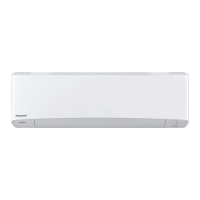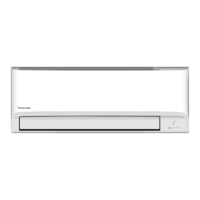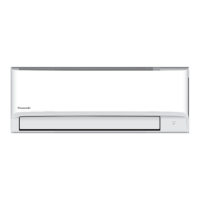Do you have a question about the Panasonic CS-RZ25VKRW and is the answer not in the manual?
Guide on how to properly insert batteries into the remote control for operation.
Instructions for setting the clock on the remote control for accurate timer functions.
How to turn the air conditioner on and off using the remote control.
Steps to select the desired operating mode (e.g., Cool, Heat, Fan).
Guidance on how to set the desired temperature for the room.
Important safety symbols and their meanings to prevent injury or damage.
Safety guidelines for the installation and use of indoor and outdoor air conditioner units.
Precautions related to the safe handling and use of the remote control.
Guidelines for safe electrical connection and operation to prevent hazards.
Recommendations for preventing overheating, fire, or electric shock related to the power cord.
Safety measures for cleaning and servicing the unit, including precautions against electric shock.
Specific safety guidelines for handling R32 refrigerant, a mild flammable refrigerant.
Procedures and precautions for installation personnel handling refrigerants and equipment.
Requirements for installation space and protection of piping to ensure safe operation.
Ensuring qualified and trained personnel perform servicing and maintenance.
Safety measures to be followed during maintenance and repair work on the system.
Procedures for checking refrigerant presence and handling leaks safely.
Ensuring fire safety by having extinguishers and eliminating ignition sources.
Importance of ventilation and checks on refrigerating equipment for safety.
Safety checks for electrical components, including capacitor discharge and earth bonding.
Safety guidelines for repairing sealed components and intrinsically safe parts.
Checking cabling condition and acceptable methods for detecting refrigerant leaks.
Safe procedures for removing and evacuating refrigerant from the system.
Requirements and safety measures for charging the system with refrigerant.
Steps and precautions for safely decommissioning the air conditioner unit.
Procedures for safely recovering refrigerant and labelling equipment after decommissioning.
Instructions for adjusting the airflow direction for different indoor unit models.
How to change the fan speed for optimal comfort and operation.
Using the Powerful and Quiet modes for quick temperature adjustment or quiet operation.
Tips for saving electrical power by adjusting settings and dimming indicators.
Guide to setting the unit's ON and OFF timers for automatic operation.
Detailed explanation of different operation modes like AUTO, COOL, HEAT, DRY, and FAN.
Recommended temperature ranges for HEAT and COOL modes to save energy.
How airflow direction works in COOL/DRY and HEAT modes with AUTO settings.
Explanation of the auto restart feature after a power failure.
How to clean the indoor unit with a soft, dry cloth and professional cleaning recommendations.
Instructions for clearing debris around the outdoor unit and drain pipe.
Steps to remove and clean the front panel of the indoor unit.
Procedure for washing, rinsing, and drying air filters to maintain performance.
Guidelines for cleaning and recommended replacement interval for anti-bacterial filters.
Identifies common operating symptoms that are not malfunctions and their likely causes.
Checks to perform before calling for servicing, covering efficiency, noise, and remote control issues.
Troubleshooting steps for missing or malfunctioning remote controls, including forced operation.
How to adjust the brightness of the unit's indicators.
Guidance on inspections after extended non-use and preparation for long periods of non-operation.
Conditions requiring consultation with an authorized dealer due to potential damage or safety risks.
List of diagnostic display codes indicating abnormalities or protection controls and their meanings.
Information on the collection and disposal of old equipment and used batteries according to regulations.
Explanation of various symbols used in the manual, including warnings and operational guidance.
Guide on how to properly insert batteries into the remote control for operation.
Instructions for setting the clock on the remote control for accurate timer functions.
How to turn the air conditioner on and off using the remote control.
Steps to select the desired operating mode (e.g., Cool, Heat, Fan).
Guidance on how to set the desired temperature for the room.
Important safety symbols and their meanings to prevent injury or damage.
Safety guidelines for the installation and use of indoor and outdoor air conditioner units.
Precautions related to the safe handling and use of the remote control.
Guidelines for safe electrical connection and operation to prevent hazards.
Recommendations for preventing overheating, fire, or electric shock related to the power cord.
Safety measures for cleaning and servicing the unit, including precautions against electric shock.
Specific safety guidelines for handling R32 refrigerant, a mild flammable refrigerant.
Procedures and precautions for installation personnel handling refrigerants and equipment.
Requirements for installation space and protection of piping to ensure safe operation.
Ensuring qualified and trained personnel perform servicing and maintenance.
Safety measures to be followed during maintenance and repair work on the system.
Procedures for checking refrigerant presence and handling leaks safely.
Ensuring fire safety by having extinguishers and eliminating ignition sources.
Importance of ventilation and checks on refrigerating equipment for safety.
Safety checks for electrical components, including capacitor discharge and earth bonding.
Safety guidelines for repairing sealed components and intrinsically safe parts.
Checking cabling condition and acceptable methods for detecting refrigerant leaks.
Safe procedures for removing and evacuating refrigerant from the system.
Requirements and safety measures for charging the system with refrigerant.
Steps and precautions for safely decommissioning the air conditioner unit.
Procedures for safely recovering refrigerant and labelling equipment after decommissioning.
Instructions for adjusting the airflow direction for different indoor unit models.
How to change the fan speed for optimal comfort and operation.
Using the Powerful and Quiet modes for quick temperature adjustment or quiet operation.
Tips for saving electrical power by adjusting settings and dimming indicators.
Guide to setting the unit's ON and OFF timers for automatic operation.
Detailed explanation of different operation modes like AUTO, COOL, HEAT, DRY, and FAN.
Recommended temperature ranges for HEAT and COOL modes to save energy.
How airflow direction works in COOL/DRY and HEAT modes with AUTO settings.
Explanation of the auto restart feature after a power failure.
How to clean the indoor unit with a soft, dry cloth and professional cleaning recommendations.
Instructions for clearing debris around the outdoor unit and drain pipe.
Steps to remove and clean the front panel of the indoor unit.
Procedure for washing, rinsing, and drying air filters to maintain performance.
Guidelines for cleaning and recommended replacement interval for anti-bacterial filters.
Identifies common operating symptoms that are not malfunctions and their likely causes.
Checks to perform before calling for servicing, covering efficiency, noise, and remote control issues.
Troubleshooting steps for missing or malfunctioning remote controls, including forced operation.
How to adjust the brightness of the unit's indicators.
Guidance on inspections after extended non-use and preparation for long periods of non-operation.
Conditions requiring consultation with an authorized dealer due to potential damage or safety risks.
List of diagnostic display codes indicating abnormalities or protection controls and their meanings.
Information on the collection and disposal of old equipment and used batteries according to regulations.
Explanation of various symbols used in the manual, including warnings and operational guidance.
| Cooling Capacity | 2.5 kW |
|---|---|
| Heating Capacity | 3.2 kW |
| Refrigerant | R32 |
| Power Supply | 220-240 V, 50 Hz |
| Type | Split System |












